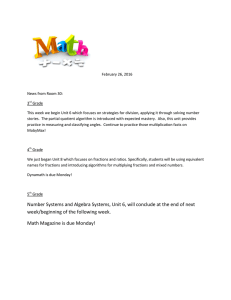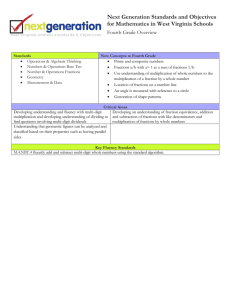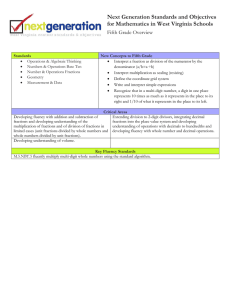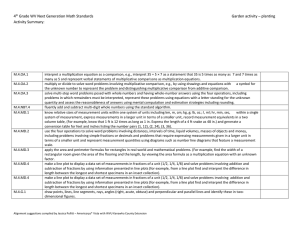Jan – March 2011 Shari Alexander Scott Harper
advertisement
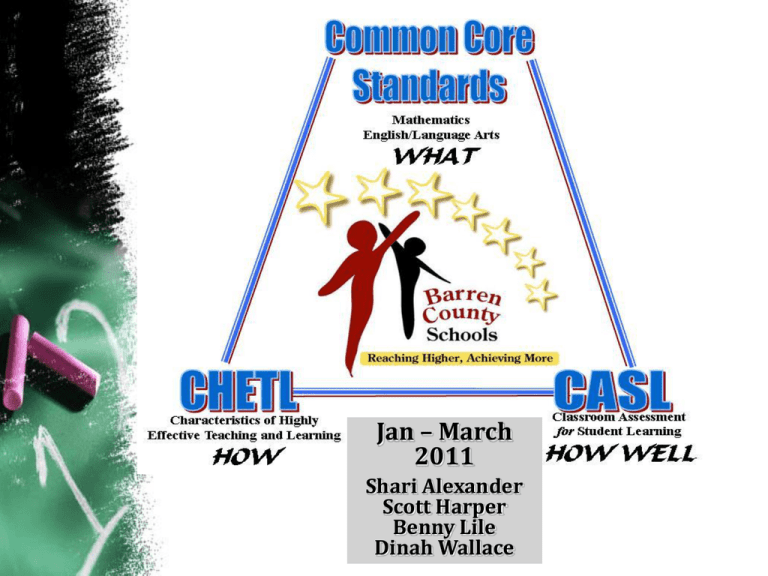
Jan – March 2011 Shari Alexander Scott Harper Benny Lile Dinah Wallace National Movement • Mathematics and English/ Language 2010 • 39 States & 2 Territories have joined Common Core Standards Initiative KY’S VISION “…from a teaching-focused-classroom to a learning-focused-classroom…” Dr. Holliday, Commissioner of Education #1 Priority is STUDENT LEARNING New Standards in English/Language Arts and Math (Fewer, Clearer, Higher.. For all students to be college/career ready) Revised Accountability Model (Achievement, Gap, Growth, College/Career Readiness, Graduation Rate, Program Reviews, EPAS system, End of Course Assessments) Improve Effectiveness of Teaching and Learning (CHETL) Balanced Assessment/Assessment Literacy (CASL) Puts the Pieces Together - Nationally Creating the National Common Core Standards in Mathematics and English/Language Arts has been a collaborative effort between state departments of education, teachers, experts in a wide array of fields, and numerous professional organizations based on national work & research from: best work of states and high-performing nations frameworks developed for the National Assessment of Educational Progress (NAEP) academic research of Marzano, Stiggins, Fullan, and others curriculum surveys & assessment data on collegeand career-ready performance Input from educators at all levels and from a variety of subjects Puts the Pieces Together - KY Leadership Networks Vision Every school district in the Commonwealth of Kentucky has a knowledgeable and cohesive leadership team that guides the professional learning and practice of all administrators, teachers, and staff so that every student experiences highly effective teaching, learning and assessment practices in every classroom, every day. Result = Every Student Proficient and Prepared for Success! Puts the Pieces Together - KY Overview of P-20 Leadership Networks • Research based approach to delivering large scale professional development and professional learning communities • Focus on building district and school level capacity • Investment and commitment to change at the classroom level • Focus on highly effective teaching and learning Content Leadership Networks • Focus on teacher and teacher leaders Administrator Leadership Networks • Building level administrators Instructional Supervisor Networks Superintendents Network Higher Education Networks Teacher Content Leadership Work Standard/Benchmark Deconstructing Standards - Knowledge Reasoning Skill STANDARDS/TARGETS/METHODS/COMMUNICATION OF RESULTS Product Standard/Benchmark: __________________________________________________________________ _____________________________________________________________________________________ Type: q Knowledge q Reasoning q q Skill Product Learning Targets – Teacher Friendly Language What are the knowledge, reasoning, skill or product targets underpinning the standard or benchmark? Knowledge Targets Reasoning Targets Skill Targets Product Targets “I Can” / Learning Targets – Student Friendly Language What are the knowledge, reasoning, skill or product targets underpinning the standard or benchmark? Knowledge Targets Reasoning Targets Skill Targets Product Targets Page 1 Teacher Content Leadership Work Standard/Benchmark Deconstructing Standards - Knowledge Reasoning Skill Product Assessments How will I assess to promote the learning and audit the achievement of the targets and standard? Assessment(s) q FOR/Formative Assessment(s) q FOR/Formative Assessment(s) q FOR/Formative Assessment(s) q FOR/Formative OF/Summative OF/Summative OF/Summative OF/Summative qq qq qq Selected response Ext. written response Personal Communication qq qq qq qq Selected response Ext. written response Performance Personal Communication qq qq Performance Personal Communication qq Performance Communication of Results How will I communicate the learning and the achievement? Assessments FOR Learning / Formative resulting in reporting of learning/growth q q FOR/Formative – Report OF/Summative Grade q q FOR/Formative – Report OF/Summative Grade Assessments OF Learning / Summative resulting in grading of achievement q q FOR/Formative – Report OF/Summative Grade q q FOR/Formative – Report OF/Summative Grade Page 2 Common Core State Standards (CCSS) Kentucky Core Academic Standards (KCAS) Common Core Standards The Common Core State Standards focus on core conceptual understandings and procedures starting in the early grades, thus enabling teachers to take the time needed to teach core concepts and procedures well—and to give students the opportunity to master them. Common Core Standards work - National •http://www.corestandards.org/ Common Core Standards work at KDE – now adopting as KY Core Academic Standards •Program of Studies being updated to reflect adoption of CCS – 571 page document is on web for public review http://www.education.ky.gov/users/otl/POS/POS%20with%2 0CCS%20for%20public%20review.pdf •http://www.education.ky.gov/KDE/Instructional+Resources/ Curriculum+Documents+and+Resources/CCS+Resources Mathematics Standards— how to read the CCSS documents for Mathematics Simple overview provides all key information at a glance. Click for close up… Overview: The math standards start with a one-page overview highlighting what is most important. 12 Simple overview provides all key information at a glance. Click for close up… Overview: The math standards start with a one-page overview highlighting what is most important. 13 Fewer standards to address KY 4th Grade Math 5 big ideas CCSS 4th Grade Math 5 domains 23 understanding standards 10 clusters 78 skill and concept standards 28 standards 15 pages 5 pages Examples make standards more concrete Represent and interpret data. • Make a line plot to display a data set of measurements in fractions of a unit (1/2, 1/4, 1/8). Solve problems involving addition and subtraction of fractions by using information presented in line plots. For example, from a line plot find and interpret the difference in length between the longest and shortest specimens in an insect collection. 14 KCAS Progression Document Operations and Algebraic Thinking Domains Clusters Use the four operations with whole numbers to solve problems Gain familiarity with factors and multiples Generate and analyze patterns Number & Operations in Base Ten Generalize place value understanding for multi-digit whole numbers Use place value understanding and properties of operations to perform multi-digit arithmetic Number & Operations: Fractions Extend understanding of fraction equivalence and ordering Build fractions from unit fractions by applying and extending previous understandings of operations on whole numbers Understand decimal notation for fractions, and compare decimal fractions Measurement and Data Solve problems involving measurement and conversion of measurements from a larger unit to a smaller unit Represent and interpret data Geometric measurement: understand concepts of angle and measure angles Geometry Draw and identify lines and angles, and classify shapes by properties of their lines and angles Mathematica 1. Make sense of problems and 1. Construct viable arguments 1. Use appropriate tools 1. Look for and make use of l persevere in solving them. and critique the reasoning of strategically. structure. Practic 2. Reason abstractly and others. 2. Look for and express regularity in 2. Attend to precision. In Grade 4, instructional time should focus on three critical areas: es quantitatively. 2. Model with mathematics. reasoning. 1.Developing understanding and fluency with multi-digit multiplication, and developing understanding of dividing to findrepeated quotients involving multi-digit dividends Students generalize their understanding of place value to 1,000,000, understanding the relative sizes of numbers in each place. They apply their understanding of models for multiplication (equal-sized groups, arrays, area models), place value, and properties of operations, in particular the distributive property, as they develop, discuss, and use efficient, accurate, and generalizable methods to compute products of multi-digit whole numbers. Depending on the numbers and the context, they select and accurately apply appropriate methods to estimate or mentally calculate products. They develop fluency with efficient procedures for multiplying whole numbers; understand and explain why the procedures work based on place value and properties of operations; and use them to solve problems. Students apply their understanding of models for division, place value, properties of operations, and the relationship of division to multiplication as they develop, discuss, and use efficient, accurate, and generalizable procedures to find quotients involving multi-digit dividends. They select and accurately apply appropriate methods to estimate and mentally calculate quotients, and interpret remainders based upon the context. 2.Developing an understanding of fraction equivalence, addition and subtraction of fractions with like denominators, multiplication of fractions by whole numbers Students develop understanding of fraction equivalence and operations with fractions. They recognize that two different fractions can be equal (e.g., 15/9 = 5/3), and they develop methods for generating and recognizing equivalent fractions. Students extend previous understandings about how fractions are built from unit fractions, composing fractions from unit fractions, decomposing fractions into unit fractions, and using the meaning of fractions and the meaning of multiplication to multiply a fraction by a whole number. 3.Understanding that geometric figures can be analyzed and classified based on their properties, such as having parallel sides, perpendicular sides, particular angle measures, and symmetry Students describe, analyze, compare, and classify two-dimensional shapes. Through building, drawing, and analyzing two-dimensional shapes, students deepen their understanding of properties of two-dimensional objects and the use of them to solve problems involving symmetry. Grade Level Span…Math Sample Operations and Algebraic Thinking Grade 3 Grade 4 Grade 5 Represent and solve problems involving multiplication and division. 3.OA.1: Interpret products of whole numbers, e.g., interpret 5 × 7 as the total number of objects in 5 groups of 7 objects each. For example, describe a context in which a total number of objects can be expressed as 5 × 7. 3.OA.2: Interpret whole-number quotients of whole numbers, e.g., interpret 56 ÷ 8 as the number of objects in each share when 56 objects are partitioned equally into 8 shares, or as a number of shares when 56 objects are partitioned into equal shares of 8 objects each. For example, describe a context in which a number of shares or a number of groups can be expressed as 56 ÷ 8. 3.OA.3: Use multiplication and division within 100 to solve word problems in situations involving equal groups, arrays, and measurement quantities, e.g., by using drawings and equations with a symbol for the unknown number to represent the problem. (Note: See Glossary, Table 2.) 3.OA.4: Determine the unknown whole number in a multiplication or division equation relating three whole numbers. For example, determine the unknown number that makes the equation true in each of the equations 8 × ? = 48, 5 = ÷ 3, 6 × 6 = ?. Understand properties of multiplication and the relationship between multiplication and division. 3.OA.5: Apply properties of operations as strategies to multiply and divide. (Note: Students need not use formal terms for these properties.) Examples: If 6 × 4 = 24 is known, then 4 × 6 = 24 is also known. (Commutative property of multiplication.) 3 × 5 × 2 can be found by 3 × 5 = 15, then 15 × 2 = 30, or by 5 × 2 = 10, then 3 × 10 = 30. (Associative property of multiplication.) Knowing that 8 × 5 = 40 and 8 × 2 = 16, one can find 8 × 7 as 8 × (5 + 2) = (8 × 5) + (8 × 2) = 40 + 16 = 56. (Distributive property.) 3.OA.6: Understand division as an unknown-factor problem. For example, find 32 ÷ 8 by finding the number that makes 32 when multiplied by 8. Multiply and divide within 100. 3.OA.7: Fluently multiply and divide within 100, using strategies such as the relationship between multiplication and division (e.g., knowing that 8 × 5 = 40, one knows 40 ÷ 5 = 8) or properties of operations. By the end of Grade 3, know from memory all products of two one-digit numbers. Solve problems involving the four operations, and identify and explain patterns in arithmetic. 3.OA.8: Solve two-step word problems using the four operations. Represent these problems using equations with a letter standing for the unknown quantity. Assess the reasonableness of answers using mental computation and estimation strategies including rounding. (Note: This standard is limited to problems posed with whole numbers and having whole-number answers; students should know how to perform operations in the conventional order when there are no parentheses to specify a particular order -Order of Operations.) Use the four operations with whole numbers to solve problems. 4.OA.1: Interpret a multiplication equation as a comparison, e.g., interpret 35 = 5 × 7 as a statement that 35 is 5 times as many as 7 and 7 times as many as 5. Represent verbal statements of multiplicative comparisons as multiplication equations. 4.OA.2: Multiply or divide to solve word problems involving multiplicative comparison, e.g., by using drawings and equations with a symbol for the unknown number to represent the problem, distinguishing multiplicative comparison from additive comparison. (Note: See Glossary, Table 2.) 4.OA.3: Solve multistep word problems posed with whole numbers and having whole-number answers using the four operations, including problems in which remainders must be interpreted. Represent these problems using equations with a letter standing for the unknown quantity. Assess the reasonableness of answers using mental computation and estimation strategies including rounding. Gain familiarity with factors and multiples. 4.OA.4: Find all factor pairs for a whole number in the range 1–100. Recognize that a whole number is a multiple of each of its factors. Determine whether a given whole number in the range 1–100 is a multiple of a given one-digit number. Determine whether a given whole number in the range 1–100 is prime or composite. Generate and analyze patterns. 4.OA.5: Generate a number or shape pattern that follows a given rule. Identify apparent features of the pattern that were not explicit in the rule itself. For example, given the rule “Add 3” and the starting number 1, generate terms in the resulting sequence and observe that the terms appear to alternate between odd and even numbers. Explain informally why the numbers will continue to alternate in this way. Write and interpret numerical expressions. 5.OA.1: Use parentheses, brackets, or braces in numerical expressions, and evaluate expressions with these symbols. 5.OA.2: Write simple expressions that record calculations with numbers, and interpret numerical expressions without evaluating them. For example, express the calculation “add 8 and 7, then multiply by 2” as 2 × (8 + 7). Recognize that 3 × (18932 + 921) is three times as large as 18932 + 921, without having to calculate the indicated sum or product. Analyze patterns and relationships. 5.OA.3: Generate two numerical patterns using two given rules. Identify apparent relationships between corresponding terms. Form ordered pairs consisting of corresponding terms from the two patterns, and graph the ordered pairs on a coordinate plane. For example, given the rule “Add 3” and the starting number 0, and given the rule “Add 6” and the starting number 0, generate terms in the resulting sequences, and observe that the terms in one sequence are twice the corresponding terms in the other sequence. Explain informally why this is so. Grade Level Shift Document Concepts New to Grade Level 4.OA.4 Determine prime and composite numbers (1-100). 4.NF.3b Decompose fractions in more than one way, justify decompositions using visual models, multiple representations of fractions. 4.NF.3c Properties of operations with mixed numbers with like denominators. 4.NF.4c Multiply fractions by a whole number, using visual fraction models and equations to represent the problem. 4.NF.7 Use decimal notation for fractions with denominators 10 or 100. 4.MD.3 Apply the area and perimeter formulas for rectangle. 4.MD.4 Make a line plot to display a data set of measurements in unit fractions. 4.MD.6 Measure angles in whole number degrees using a protractor. Draw angles of specified measure. 4.MD.7 Use angle measures to decompose angles. Solve addition and subtraction problems to find unknown angles on a diagram in real world and mathematical problems. 4.G.2 Classify two-dimensional figures based presence or absence of attributes (parallel or perpendicular lines). Grade th 4 Concepts Moved From Grade Level Kindergarten Attributes of basic three-dimensional objects (spheres, cones, cylinders, pyramids, cubes, triangular and rectangular prisms); apply these attributes to solve real-world problems. Identify basic two-dimensional figures in different orientations. rd 3 grade Attributes of two dimensional shapes and shapes that share attributes can define larger categories. Represent and interpret data-bar graphs and pictographs (also 2nd grade). The actual process of learning to read a thermometer does not have a standard. It is considered a life skill and is also introduced in science. th 5 grade Identify and graph ordered pairs on a positive coordinate system (Quadrant 1). Emphasis on preparing students for college and the careers of the 21st Century Anchor standards serve as the spine for all ELA grade levels 18 ELA Standards— how to read the CCSS documents for ELA & Literacy in Social Studies/History, & Technical Subjects College and Career Readiness Anchor Standards ELA – 4 sets: Reading, Writing, Language, and Speaking and Listening – Social Studies, Science, and Technical Subjects—2 sets: Reading and Writing – All of the standards within the grade bands are linked to these anchors with building complexity as the grades increase Strands Within each set, the anchors are divided into strands. Grade Bands The ELA anchors are grouped K‐5 and 6‐12. (6‐12 only for Social Studies, Science, and Technical Subjects). Standards The standards within grades and grade bands provide further specificity in a developmentally appropriate progression toward meeting the expectation of the anchor. Appendices with exemplar texts, performance tasks, student work Literacy skills are integrated into science, social studies, and technical subjects 20 Literacy skills are integrated into science, social studies, and technical subjects 21 Supporting the Common Core Implementation The How & How Well We know what the research says Classrooms headed by “most effective” teachers have student achievement gains of 53 percentage points over the course of one year versus classrooms led by the “least effective” teachers averaging gains of only 14 percentage points. CHETL – KDE Site http://www.education.ky.gov/KDE/Ins tructional+Resources/Highly+Effective +Teaching+and+Learning/HETL+Com mon+Characteristics.tm The Characteristics of Highly Effective Teaching and Learning create a common point of reference for discussing effective practices in teaching and learning by describing the role of the teacher and student in an exemplary instructional environment. The document is divided into five components. Learning Climate Classroom Assessment and Reflection Instructional Rigor and Student Engagement Instructional Relevance Knowledge of Content Each of these components is supported with a list of characteristics of effective teacher practices and student actions. The Characteristics are based upon some of the most current research findings from several resources. CHETL – KDE Site http://www.education.ky.gov/KDE/Ins tructional+Resources/Highly+Effective +Teaching+and+Learning/HETL+Com mon+Characteristics.tm CHETL – KDE Site http://www.education.ky.gov/KDE/Ins tructional+Resources/Highly+Effective +Teaching+and+Learning/HETL+Com mon+Characteristics.tm Assessment for Learning Classroom Assessment for Student Learning (by Rick Stiggins, Judith Arter, Stephen Chappuis, and Jan Chappuis) makes the distinction between assessment of and for learning. The purpose of assessment of learning is to summarize the achievement status of individuals and groups at a point in time. • "assessment of learning“ "summative assessment" • Classroom-level summative assessment usually have grade or a statement of level of mastery. Assessment for Learning With CASL the major focus is assessment for learning— Research shows that assessment for learning practices can dramatically improve student motivation and learning. Assessment for learning strategies address the information needs of both teachers and students. Assessment for Learning Five Keys to Quality Classroom Assessments Stiggins, et al. (2004), p 13 Let’s take a closer look at the Common Core State Standards
